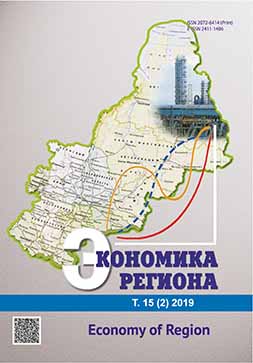АНАЛИЗ И МОДЕЛИРОВАНИЕ ТЕНДЕНЦИЙ РАЗВИТИЯ СИСТЕМЫ ТЕРРИТОРИАЛЬНОГО РАССЕЛЕНИЯ В РОССИИ
Analysing and Modelling of Trends in the Development
of the Territorial Settlement System in Russia
Author(s): Rafael Valiakhmetovich Fattakhov, Marsel Malikhovich Nizamutdinov, Vladimir Vladimirovich OreshnikovSubject(s): Human Geography, Demography and human biology, Rural and urban sociology, Socio-Economic Research
Published by: Институт экономики Уральского отделения Российской академии наук
Keywords: territorial resettlement trends; cities of Russia; regional economy; migration; statistical analysis and modelling; Zipf ’s law; population forecast; urban population; agglomerations;
Summary/Abstract: Population change is a very important indicator of the social and economic system’s state and development. This change is most clearly observed in the long term. In the second half of 20th century, the studies on the development of Russian settlement system have established that in the recent years population growth is almost entirely caused by the growth of urban population migration. Thus, we analyse the impact of the cities’ size on growth rates, and highlight territorial features and the effects from the economy’s structural reorganization. The analysis has demonstrated the cities’ structural transformation. The residents’ concentration in large localities is a well-established vector of the settlement system’s development in our country. The proportion of the population living in million-person cities has increased by 54.3 % over the past 50 years. The small and medium-sized towns act as the main sources of migrants and “suppliers” of labour and intellectual capital. In our research, we used methodology based on systems analysis of both urban development and group settlement systems. We applied methods of structural and dynamic analysis, and economic and mathematical modelling. The Zipf ’s curve for Russian cities with a population of at least 100 thousand people indicates that a group of 11 million-person cities is dominant in Russia. Moreover, we presented the results of a cross-country comparison of settlement patterns. The comparison has revealed that the situation in the Russian Federation doesn’t fully correspond to the situation in developed or developing countries. The analysis of population’s structure and dynamics in Russian cities has allowed predicting the change in the urban population until 2025 (growth of about 1.8 %).The population growth rate is expected to be higher in the million-person cities. The increasing contrast of settlement, the expanding gap between megacities and provincial towns, formation of an agglomerative system of settlements will inevitably lead to an aggravation of infrastructure problems, which requires a transition to controlled development. Taking into account the identified trends will enhance the efficiency of forecasting the country’s economic development and the strategy of the settlement system’s optimization in Russia.
Journal: Экономика региона
- Issue Year: 15/2019
- Issue No: 2
- Page Range: 436-450
- Page Count: 15
- Language: Russian

